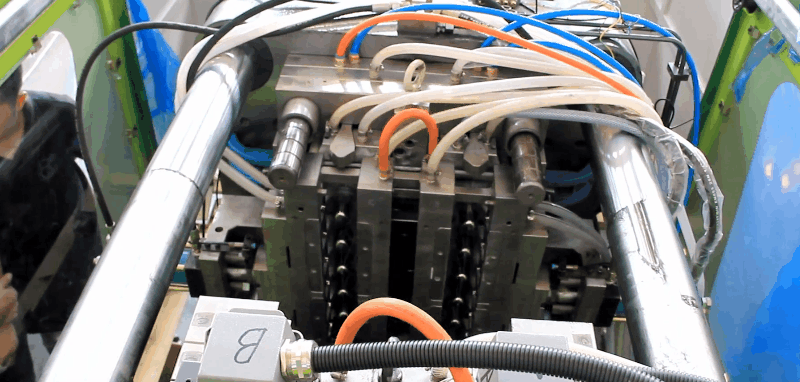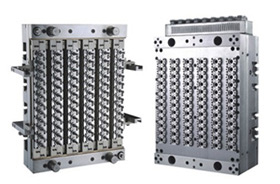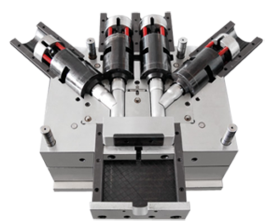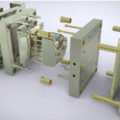Poly (hexamethylene adipamide), Polyamide 66, or Nylon 66 (PA66) is an engineering-grade thermoplastic. PA66 has higher strength but lower impact resistance than PA6. Applications for Plastic PA66 automotive industry appliance housings generally where impact resistance and strength are required Competes with PA6 for most applications. Plastic PA66 Injection Molding Processing Conditions Runners and Gates for PA66 injection molds The gate location is important because of very fast freeze-off times. Any type of gate can be used; the aperture should not be less than half the thickness of the part. When hot runners are used, the size of the gates can be smaller than when cold runners are used, because premature freeze-off is prevented. When using circular tapered gates, the minimum diameter of the gate should be 0.75 mm. Chemical and physical properties PA66 homopolymer is produced by the polymerization of hexamethylene diamine and adipic acid (a dibasic acid). PA66 is a semicrystalline-crystalline material with one of the highest melting points among commercially available polyamides. The grades have strength and stiffness that is retained at elevated temperatures. PA66 does absorb moisture
Read more →Polyamide 12 or Nylon 12 (PA12) is an effective electrical insulator and its properties are not as sensitive to humidity as other polyamides. PA12 has good resistance to shock and many chemicals, and is extensively modified with plasticizers and reinforcements. In comparison to PA6 and PA66, PA12 materials have a lower melting point, lower density, and much lower moisture regain. PA12 is not resistant to strong oxidizing acids. Typical Applications for Plastic PA12 – gear wheels – water meters business machines cable ties cams slides bearings Injection Molding Processing Conditions Plastic PA12 Injection Molding Processing Conditions Runners and Gates for Plastic PA12 injection molds Runner diameters for unfilled grades can be as small as 3–5 mm because of the low viscosity of the material. Reinforced grades require larger diameters (5–8 mm). The runner shape should be the full round type. Sprues should be as short as possible. A variety of gates can be used. To avoid highly stressed components or excessive shrinkage, small gates should not be used for large parts. The thickness of the gate should be equal to
Read more →Generic Class Polyamide 6, Nylon 6, or polycaprolactam (PA6) is one of the major engineering thermoplastics. PA6 is tough, has excellent abrasion resistance, good chemical resistance, fatigue endurance, lubricity, impact strength, high strength, and rigidity. Applications – structural applications – bearings Plastic PA6 Injection Molding processing conditions Runners and Gates of PA6 Injection Molding Processing Conditions The gate location is important because of very fast freeze-off times. Any type of gate can be used; the aperture should not be less than half the thickness of the part. When hot runners are used, the size of the gates can be smaller than when cold runners are used. When using circular tapered gates, the minimum diameter of the gate should be 0.75 mm. Chemical and Physical Properties The molecular structure of polyamides consists of amide (CONH) groups joined by linear aliphatic sections (based on methylene groups). The toughness, rigidity, crystallinity, and thermal resistance of polyamide materials are due to the strong interchain attraction caused by the polarity of the amide groups. The CONH groups also cause a lot of moisture absorption. Nylon
Read more →LDPE (Low Density Polyethylene) is an odourless, tasteless and nontoxic polymer that is suitable for food contact applications. LDPE has higher impact strength than HDPE, but lower tensile strength, viscosity, and chemical resistance. Typical Applications closures bowls bins pipe couplings Plastic LDPE injection molding processing conditions Runners and Gates of Injection Moulding Molds All conventional types can be used; LDPE is suitable for hot runner molds. Insulated hot tip runners are preferred for frequent color changes. Chemical and Physical Properties of LDPE LDPE is produced by the polymerization of ethylene at high pressure and temperature. The material is semicrystalline-crystalline. The crystallinity level is low because of chain branching. The material is tough but possesses moderate tensile properties and exhibits creep. However, it has good impact and chemical resistance. It is an easy flow material because of long chain branching. Commercial materials have densities in the range of 0.91–0.94 g/cm⊃3;. LDPE is permeable to gases and vapors. Very close tolerances are not possible with this material and its relatively large coefficient of thermal expansion makes it less suitable for long-term applications.
Read more →High-density polyethylene (HDPE) is an odorless, tasteless, and nontoxic polymer that makes it suitable for food contact applications. HDPE has greater tensile strength, heat distortion temperature, viscosity, and chemical resistance than LDPE, but has a lower impact strength. Typical Applications – containers in refrigeration units – storage vessels – household goods (kitchenware) – seal caps – PET bottle bases – blow-molding (packaging applications) Plastic HDPE Injection Molding Processing conditions Runners and Gates for HDPE Injection Mold Diameters of runners range from 4 mm–7.5 mm (typically 6 mm). Runner lengths should be as short as possible. All types of gates can be used. Gate lands should not exceed 0.75 mm in length. Ideally suited for hot runner molds; an insulated hot tip runner is preferred when there are frequent color changes. Chemical and Physical Properties HDPE is produced from the polymerization of ethylene; lower temperature and pressure conditions are used compared to the production of low-density polyethylene. The material is free from branching and this is made possible by the use of stereospecific catalysts. Because of molecular regularity, HDPE has a
Read more →Acrylonitrile-Butadiene-Styrene (ABS) offers superior processibility, appearance, low creep, excellent dimensional stability, and high impact strength. Typical Applications – automotive 1. instrument panels 2.. interior trim panels 3. glove compartment doors 4. wheel covers 5. mirror housings – refrigerators – small appliance housings – power tools applications 1. hair dryers 2. blenders 3. food processors 4. lawnmowers – recreational vehicles 1. golf carts 2. jet skis – telephone housings ABS Injection Molding Processing Conditions ABS Chemical and Physical Properties ABS is produced by a combination of three monomers: acrylonitrile, butadiene, and styrene. Each of the monomers impart different properties: hardness and chemical and heat resistance from acrylonitrile; processibility, gloss, and strength from styrene; and toughness and impact resistance from butadiene. Morphologically, ABS is an amorphous material. The polymerization of the three monomers produces a terpolymer which has two phases: a continuous phase of styrene-acrylonitrile (SAN) and a dispersed phase of polybutadiene rubber. The properties of ABS are affected by the ratios of the monomers and molecular structure of the two phases. This facilitates a high level of flexibility in product design
Read more →Polyvinyl chloride (PVC) is a widely used polymer. The range of additives used with this polymer can alter its physical properties to create a tough rigid polymer used for water pipes through to a pliable material used for fabric applications. Properties of Polyvinyl chloride PVC is a thermoplastic polymer. Its properties are usually categorized based on rigid and flexible PVCs. Properties Typical Applications – water distribution piping – home plumbing – house siding – business machine housings – electronics packaging – medical apparatus – packaging for foodstuffs PVC Injection Molding Processing Conditions Runners and Gates for PVC injection molds All conventional gate types can be used. Pin-point and circular tapered gates are used for molding small components and fan gates are typically used for thick sections. The minimum diameter of pin-point or circular tapered gates should be 1 mm and the thickness of fan gates should not be less than 1 mm. Sprues should be as short as possible; typical runner sizes are 6–10 mm and should have a full round cross-section. Insulated hot runners and certain types of hot
Read more →






